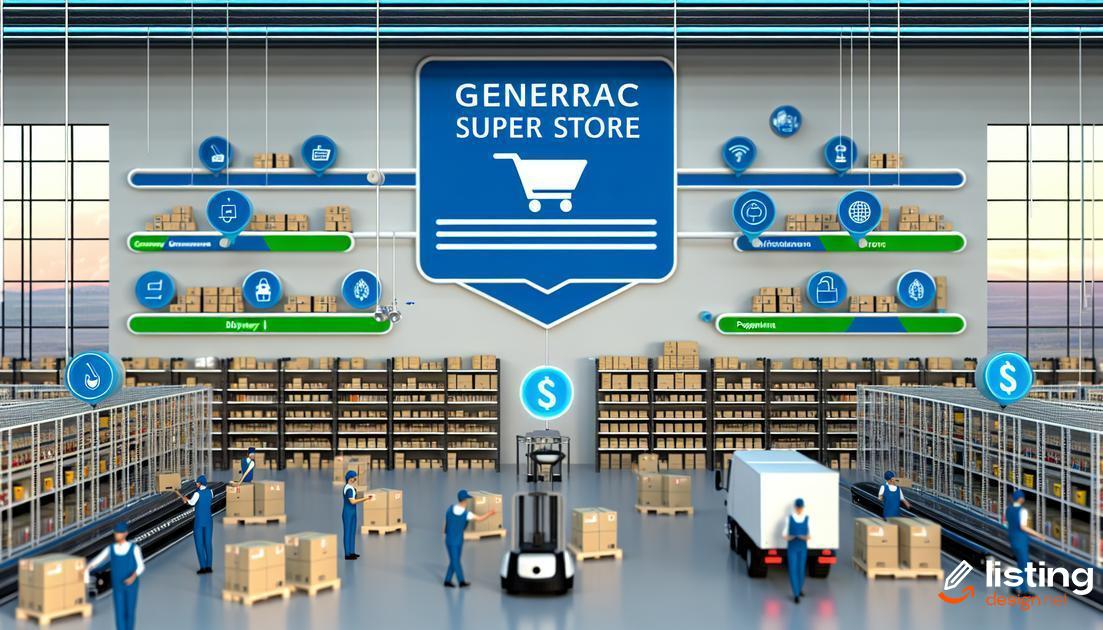When it comes to choosing between Walmart vs Amazon fulfillment, small business owners face a critical decision. Both platforms offer robust services, but each has its unique advantages. This post will explore the differences and help you determine which is best suited for your business needs.
Table of Contents
Understanding Fulfillment by Amazon (FBA)
Fulfillment by Amazon (FBA) is a service provided by Amazon to help businesses store, pack, and ship their products. When you utilize FBA, Amazon handles the logistics of storing and shipping your products from their vast network of warehouses. Compared to other fulfillment services, FBA is known for its efficiency and reach, making it an attractive option for many businesses.
One significant advantage of FBA is Amazon Prime eligibility. Products fulfilled by Amazon can qualify for Amazon Prime two-day shipping, providing a major selling point that attracts more customers. Moreover, FBA takes care of customer service and returns, alleviating these burdens from the seller’s shoulders.
However, FBA’s cost structure can be complex, involving various fees such as storage, fulfillment, and optional services like labeling. For some businesses, these fees can add up, impacting their overall profitability. Therefore, careful analysis of costs and benefits is essential.
It’s also important to note that FBA requires you to adhere to Amazon’s stringent inventory guidelines, including packaging and labeling requirements. Failure to comply can result in penalties or delays in your products being available for sale. Despite these challenges, many businesses find that the extensive reach and operational efficiencies offered by Amazon make FBA a valuable service.
Comparing to Walmart Fulfillment Services (WFS)
While FBA offers numerous advantages, understanding how it stacks up against Walmart Fulfillment Services (WFS) is crucial for making the best decision for your business. Walmart’s service aims to rival Amazon’s capabilities, with distinct differences in cost, shipping speed, and overall seller support. By comprehending both platforms, you can better determine which aligns with your business needs and goals.
Overview of Walmart Fulfillment Services (WFS)

Overview of Walmart Fulfillment Services (WFS)
Walmart Fulfillment Services (WFS) provides third-party sellers with a robust logistics and fulfillment network, enabling them to leverage Walmart’s extensive infrastructure. Sellers benefit from competitive pricing, access to Walmart’s expansive customer base, and managed storage solutions.
Key advantages of WFS include streamlined integration with Walmart’s online marketplace, easy-to-use inventory management tools, and transparent fee structures. Sellers can expect efficient pick, pack, and ship processes, which help maintain high levels of customer satisfaction.
WFS ensures that products remain in-stock and are delivered promptly to customers. Additionally, sellers receive support through dedicated account management and access to Walmart’s customer service team, ensuring a seamless experience from listing to delivery.
In comparison to Amazon’s fulfillment options, sellers using WFS can also enjoy fewer restrictions on product categories and a broader range of acceptable merchandise. This flexibility can be crucial for businesses looking to diversify their online sales channels effectively.
Cost Comparison: FBA vs WFS
When considering the cost differences between Fulfillment by Amazon (FBA) and Walmart Fulfillment Services (WFS), several factors come into play. Both platforms have unique fee structures that can impact your profit margins.
FBA charges include fulfillment fees based on the size and weight of the item and storage fees which vary based on the time of the year. From January to September, storage fees are lower. During peak seasons (October through December), they increase significantly.
On the other hand, WFS implements a more simplified pricing structure. They charge a single fulfillment fee, which includes pick, pack, and shipping, as well as storage fees that are similar to FBA’s, based on volume and the duration the items are stored.
One notable difference between FBA and WFS is the way they handle returns. Amazon includes return processing as part of their fulfillment fees, making it easier for sellers to manage costs. Walmart, however, charges an additional fee for returns processing, which can increase your overall expenses.
Moreover, both platforms offer discounts based on usage. For example, Amazon provides lower fees for high-volume sellers through their FBA Subscribe and Save program. Similarly, Walmart offers volume-based discounts but with fewer tiers compared to Amazon.
Considering subscription fees, Amazon charges a monthly subscription fee for professional sellers, whereas Walmart does not have a subscription fee for their fulfillment service. This can be a crucial factor for sellers with lower volume or those just starting out.
Shipping Speed: Amazon vs Walmart

When it comes to shipping speed, both Amazon and Walmart offer competitive options, but there are distinctive differences between the two. Amazon Prime is well-known for its super-fast shipping, often providing same-day or next-day delivery in many metro areas. This rapid fulfillment is supported by Amazon’s extensive network of warehouses and logistics prowess, ensuring products move quickly from storage to the customer.
Walmart, on the other hand, leverages its physical store locations as additional distribution centers. This strategy allows Walmart to offer two-day shipping on many items through its Walmart Fulfillment Services (WFS). In some cases, Walmart can also provide same-day delivery on specific products thanks to its integration with local stores.
One key advantage of Amazon’s shipping speed is the obligatory Amazon Prime membership, which encourages faster fulfillment and creates a loyal customer base. However, Walmart Plus is a competitive alternative that offers similar speedy delivery options for a comparable membership fee.
Ultimately, the shipping speed offered by Amazon and Walmart depends on several factors, including inventory location, demand, and logistical efficiency. Both platforms continuously invest in their delivery infrastructure to reduce shipping times and improve the overall customer experience.
Inventory Control and Management
Effective inventory control and management is vital whether you choose Amazon or Walmart for fulfillment. Both platforms provide robust tools, but understanding the nuances can impact your business efficiency.
Amazon FBA uses an advanced inventory management system allowing sellers to track real-time inventory levels, automate replenishment, and predict demand. This ensures that stockouts are minimized and customer satisfaction is maintained. Sellers can integrate third-party inventory management solutions, enhancing control and visibility.
On the other hand, Walmart Fulfillment Services (WFS) also offers a sophisticated inventory tracking system. WFS emphasizes accuracy and efficiency in inventory handling. Their system ensures that products are quickly received, stored, and shipped accurately, reducing errors and increasing speed.
Both platforms support bulk inventory uploads and automated repricing tools. However, Walmart’s marketplace may offer less competition, making it easier for new brands to get noticed. Inventory thresholds and restrictions vary, with Amazon often being more flexible concerning stock levels.
Choosing between the two depends on your business needs. If you prioritize advanced analytics and integration capabilities, Amazon’s sophisticated tools are beneficial. For sellers looking for less competitive pressure, Walmart provides a viable alternative with reliable management features.
Customer Service and Returns

Effective customer service and a straightforward returns process are crucial for maintaining customer loyalty. Both Amazon and Walmart excel in these areas but have distinct approaches.
Amazon’s customer service is renowned for its efficiency and availability. With 24/7 support through multiple channels, including live chat, phone, and email, Amazon ensures customers can easily reach out for assistance. Their returns policy is also very customer-friendly, offering pre-paid return labels and straightforward procedures for most products.
Walmart, on the other hand, leverages its vast network of physical stores to provide comprehensive customer service. This omnichannel approach allows customers to return online purchases in-store, offering greater convenience for those who prefer face-to-face interactions. Additionally, their customer service representatives are accessible via phone and online platforms.
Both platforms prioritize customer satisfaction through robust service and returns policies. Amazon’s strength lies in its seamless online experience, while Walmart’s advantage is its extensive brick-and-mortar presence, offering flexibility in returns and support.
Seller Support and Infrastructure
When evaluating seller support and infrastructure between Walmart and Amazon, both platforms offer extensive systems to help sellers streamline their operations. Amazon boasts a robust infrastructure with numerous fulfillment centers worldwide, state-of-the-art technology, and comprehensive training materials. Their Seller Central interface provides tools for inventory management, order processing, and performance analytics.
On the other hand, Walmart has been enhancing its seller support to compete with Amazon. The Walmart Marketplace provides sellers with access to a broad audience and offers various tools for order fulfillment and inventory tracking.
Technical Support and Resources
Amazon sellers can access a wealth of resources, including extensive FAQs, detailed SEO guides, and dedicated account managers for those using its Fulfillment by Amazon (FBA) service. Walmart also offers technical support through its Seller Center, with a focus on helping newer sellers navigate their platform.
Training and Development
Amazon provides Amazon Seller University, featuring a comprehensive collection of video tutorials and articles. Similarly, Walmart offers a range of training through their Walmart Marketplace University, ensuring sellers are well-informed about best practices and compliance guidelines.
Overall, while Amazon may have a more mature infrastructure and a wealth of resources, Walmart is closing the gap by continuously improving its support systems to provide a competitive and supportive environment for its sellers.
Which Platform Should You Choose?

When it comes to choosing between Amazon’s Fulfillment by Amazon (FBA) and Walmart Fulfillment Services (WFS), you need to consider several factors based on your business needs and goals. Both platforms offer unique advantages and cater to different types of seller requirements.
Market Reach and Audience: Amazon has a vast customer base with millions of Prime members who expect fast, reliable delivery. On the other hand, Walmart is expanding quickly in the e-commerce space, leveraging its extensive network of physical stores to offer competitive fulfillment options.
Cost Structure: FBA fees can include storage costs, fulfillment fees, and additional charges based on peak seasons or specific product categories. WFS has a more straightforward pricing model but requires you to meet certain criteria like being a Marketplace seller.
Shipping and Delivery: FBA is known for quick shipping, especially for Prime members. Walmart also offers competitive shipping times and benefits from its physical stores as distribution points, which can lead to faster delivery for some items.
Inventory Management: FBA provides sophisticated inventory management tools which can help streamline your logistics. Walmart’s platform also offers solid inventory management but may require more manual intervention from the seller.
Customer Service: Amazon provides extensive customer service options to help manage returns and refunds. Walmart emphasizes strong customer support and has policies in place to facilitate easy returns both online and in-store.
Seller Support: Amazon has a robust infrastructure for seller support including various resources, webinars, and dedicated account managers for larger sellers. Walmart is continually enhancing its support system but may not yet match the comprehensiveness of Amazon’s platform.
Ultimately, evaluating these factors in the context of your business will guide you towards the best platform for your fulfillment needs.


